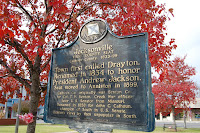Ready for a non-conventional history lecture?
It just so happens that the
Jacksonville State University Drama Department is putting on a musical named “Bloody, Bloody Andrew Jackson”. This
musical is about our 7th president’s childhood on the frontier and
about his controversial reign in the White House. This musical will incorporate
facts along with some pieces of fiction, and some material may not be appropriate for those under 16.
Now,
let’s learn more about the true
Andrew Jackson.
Born March 15, 1767, to Andrew and
Elizabeth Hutchinson Jackson, Scots-Irish colonists who immigrated to the
states from Ireland in 1765, in the Carolinas. Unfortunately, Andrew was born 3
weeks after his father’s death. At the age of 13, he joined the militia in the
Revolutionary war and was captured, along with his brother Robert, by the
British in 1781. Andrew was 14 when they were released, and his brother and
mother both died within weeks. The death of his family, leaving him an orphan,
lead to his antipathy of the British.
In his late teens, Andrew started
studying law in Salisbury, North Carolina. He was admitted to the bar in 1787
and appointed prosecuting attorney for the western region of NC at the age of
21. Andrew became very rich and obtained a plantation, The Hermitage, in Davidson County,
Tennessee. When Andrew died, he had around 150 slaves working the cotton on his
plantation.
Andrew Jackson was the 1st
president to assume command of his veto power. He became involved with a battle
against the 2nd Bank of the United States. Andrew believed that the
bank was corrupt, manipulated paper money, and had too much power over the
economy. His opponent in the 1832 re-election fought to reinstate the bank and
sent a bill to Congress, which Andrew vetoed against. During his 2nd term as
president, Andrew was the target of the 1st presidential assassination
attempt in American history.
His legacy also has a lot of
controversy with the Native Americans. Nearby Ohatchee includes the site of the former Fort Strother, Andrew Jackson’s headquarters during part of the Creek Indian War. In fact, there is a memorial off Highway 144 marking the Battle of Tallaseehatchee in 1813. There a marker also recaps the story of Lyncoya. Legend says that General Jackson found a
dead Creek Indian woman embracing her infant son, and when Jackson feared that
the child could be killed, he became his “protector,” nursed him back to
health, and took him to the family home, The Hermitage. Rachel Jackson,
Andrew’s wife, named the child Lyncoya, adopted him, raised him and educated
him as their own.
So how is Andrew Jackson connected
to Jacksonville, Alabama?
 Founded in 1833, the land for the city
of Jacksonville was a part of the Treaty of Cusseta 1832. The Creeks ceded the
remainder of their land east of the Mississippi River in east Alabama to the
U.S. government. There were many Creek Chiefs involved including Chief Ladiga. Jackson
hoped that the Creeks would either become U.S. citizens and accept individual
homesteads or move west. When he signed the Indian Removal Act of 1830, it
forced many Native Americans to move west of the Mississippi River. Andrew also
refused to enforce the Supreme Court’s decision, twice, when they ruled that
the state of Georgia had no authority to seize 9 million acres of land that
belonged to the Cherokee Tribe, which lead to the Trail of Tears.
Founded in 1833, the land for the city
of Jacksonville was a part of the Treaty of Cusseta 1832. The Creeks ceded the
remainder of their land east of the Mississippi River in east Alabama to the
U.S. government. There were many Creek Chiefs involved including Chief Ladiga. Jackson
hoped that the Creeks would either become U.S. citizens and accept individual
homesteads or move west. When he signed the Indian Removal Act of 1830, it
forced many Native Americans to move west of the Mississippi River. Andrew also
refused to enforce the Supreme Court’s decision, twice, when they ruled that
the state of Georgia had no authority to seize 9 million acres of land that
belonged to the Cherokee Tribe, which lead to the Trail of Tears.
In honor of the 7th
President Andrew Jackson, the city was renamed from Drayton to Jacksonville in
1835.
A few
years later, in 1883, Jacksonville State University was founded.
Make sure to get your
tickets and go to Jacksonville State University and experience “Bloody, Bloody Andrew Jackson,” Show
times: February 18-21 and 25-28, 2016 at 7:00 p.m.
Blogger: Brittany Noell, JSU Student (2012-2016)



No comments:
Post a Comment